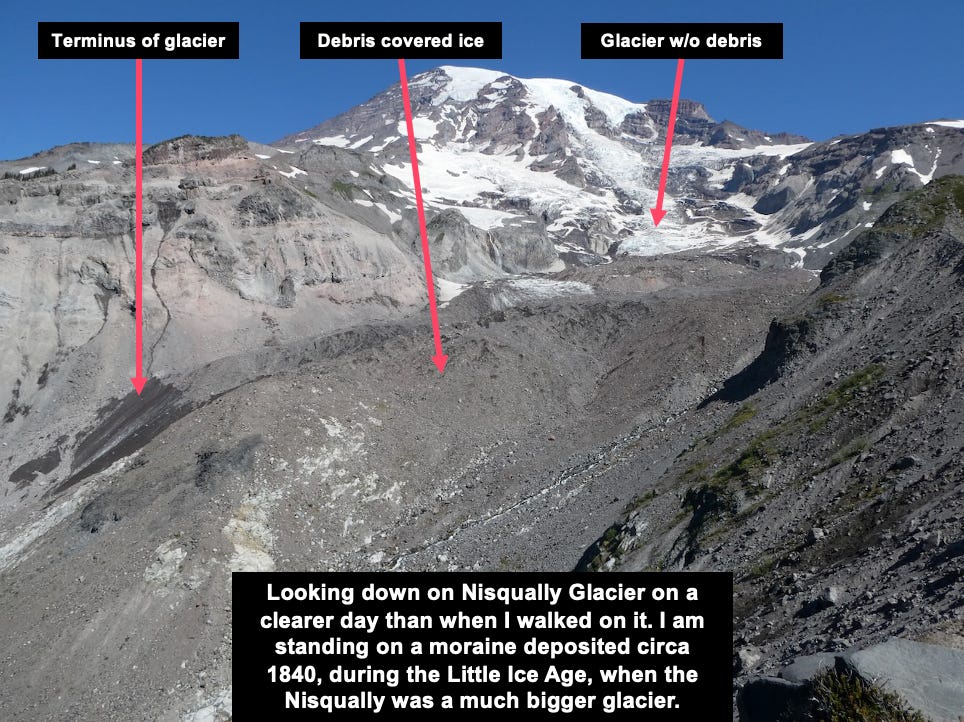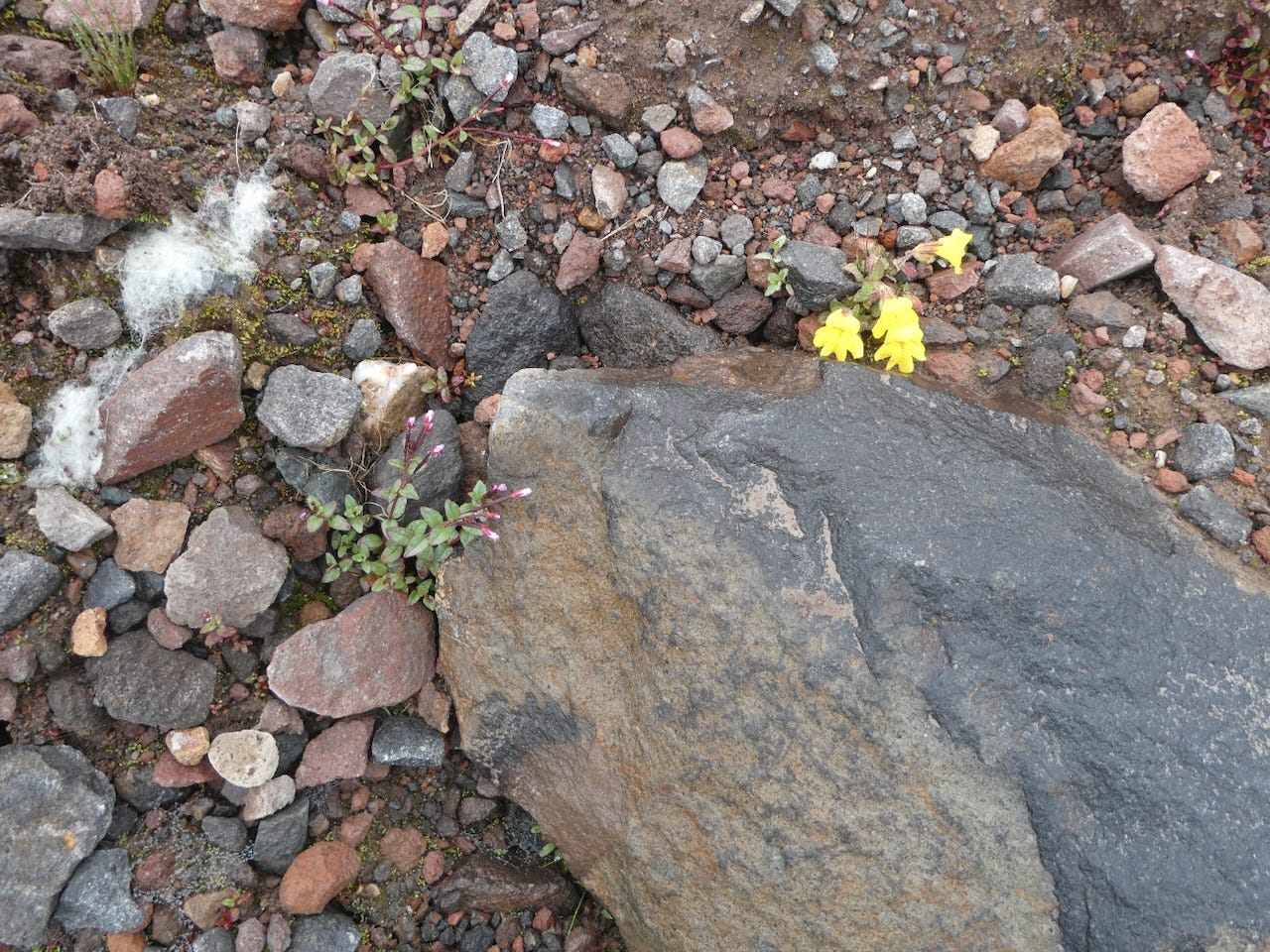Recently, I hiked out onto the Nisqually Glacier on Mt. Rainier with NPS geologist Taylor Kenyon to change the batteries on two seismic probes he had set up to monitor water discharge and sediment movement. We were on the lower end of the glacier on rock and rubble that the mountain had shed atop the ice, forming a blanket of debris. It was amazing. Ranging in size from mud to boulders bigger than a VW microbus, the debris forms an undulating surface that mirrors the motion of the ice underneath with valleys, mounds, and ridges, some towering above me.
Most of the relief comes from what is known as deflation; as the glacier retreats, the surface shrinks and the rock and rubble sort of collapses onto itself and forms the complicated topography. (Think about the topographic difference between a grape and its shrunken self, a raisin.) We constantly had to worry about rocks moving and falling either because of our walking on them or because the surface was simply unsteady, which gave the terrain a sense of constant motion and change. Taylor told me that the place where he had set up one of his seismic probes eight years ago, near the terminus, which now is debris covered, had been entirely under ice when he had started his study. (I also felt a distinct sense of mystery on the debris because fog limited our visibilty for much of the day to about 100 feet.)
As we walked across the debris, I regularly heard flowing water and saw several streams and small pools, along with what looked like sinkholes, where the ice was swallowing rocks. We also passed by a crevasse, one of a handful of locations where the ice was partially visible under a thin sheet of sand and silt. On our return, Taylor pointed out the difference between our route, on the lateral moraine, which was dry, and the glacier, where the ice kept the sediment cover wet and therefore darker.
What surprised me most were the ecosystems of lovely plant gardens with wildflowers, including purple penstemons (Penstemon davidsonii), yellow monkeyflowers (Erythranthe caespitosa), white pearly everlasting (Anaphalis margaritacea), and magenta willowherbs (Epilobium sp.). (I also saw mountain goat fur at one location and Taylor told me that he has seen mountain goats on the glacial debris cover; we heard marmots whistling, too.) It seemed so incongruous for plants to grow here, atop a several hundred-foot-thick glacier, though a study on the Carbon Glacier, on the north side of Rainier found 41 species including trees such as Douglas fir, mountain hemlock, and lodgepole pine, some up ten feet tall and perhaps 30 plus years old.
After studying the Carbon, and glaciers in China, Europe, and Chile, a team of researchers made an intriguing hypothesis, that during the Pleistocene (2,580,000 to 11,700 years ago), when much bigger alpine glaciers than at present spread in mountain ranges such as the Cascades, debris covered glaciers (DCGs) served as refugia for subsequent plant recolonization. Not only do DCGs have unique microclimates suitable for plant growth, they also facilitate the growth of typically alpine flora at lower elevations because of the ice cooled soils. DCGs, therefore, acted as nurseries, harboring imperiled plants that later dispersed, primarily by wind but supplemented by animals, to open habitat, previously wiped clean of vegetation by the ice that carried the seeds of new life.
The researchers subsequently complemented their original hypothesis. In addition to serving as refugia in the past, DCGs have the potential to be future refugia in our warming world. Studies show that with higher temperatures plants will have to migrate up in elevation, a process already playing out in mountain ranges globally. Some plants, as well as insects and arthropods, may find the space and habitat to move up but others will not be located within high enough mountains or be on summits with too little habitat. If this flora and fauna could find an alternate habitat, such as the chilled debris cover of a nearby glacier, they may be able to thrive and survive, assuming that the glacier survives climate change, too.

As I have been thinking about glaciers for my next book, I am constantly amazed by their complexity. Glaciers have been a primary shaper of topography; highlight the tolls of climate change; provide water essential for downstream aquatic creatures; may have contributed to post-Ice Age plant recolonization; and may be important for future plant survival. Far more than simply sheets of ice that grace our mountains and enhance their distinction and beauty, glaciers are an essential element of the Pacific Northwest landscape, past, present, and future.
For those of us in the PNW, who haven’t seen rain in far too long, here’s some splendid descriptions of rain and its many qualities.
And, here’s a great story of sleuthing about a Seattle mystery. Good job, Susanna, on ferreting out the story of Madison Street’s lovely blue tile markers.







I love that, of course, the surface of glaciers is more complicated than I knew, and that the refugia exist. It reminds me of the Duwamish River, where plants and animals find a way to survive in a harsh environment. I also hate that they will be needed. So many wasted chances to prevent this situation.
Also - Bravo to Suzanne! I love a good sleuthing story!
My favorite glaci:al garden item are "tribbles" of moss that form when conditions are right.
After weeks on tromping around on the upper slopes where only "watermelon snow", the occasional invertebrate and windblown detritus reminded us of the exsistence of life on elsewhere earth, I recall the delight of finding green moss balls some the size of tennis balls, surviving on glacial moraines on Alaska's Matanuska glacier.